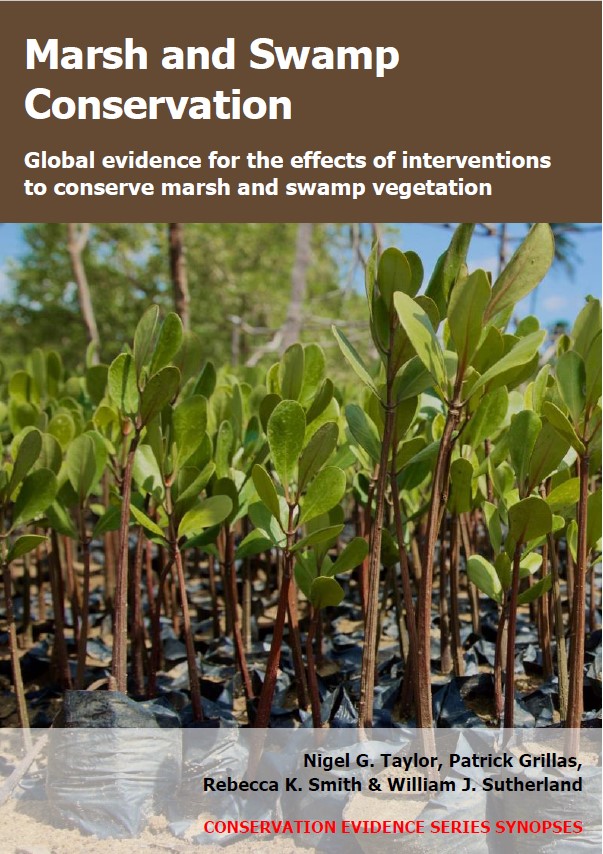Abandon cropland: allow freshwater marshes or swamps to recover without active intervention
-
Overall effectiveness category Likely to be beneficial
-
Number of studies: 4
View assessment score
Hide assessment score
How is the evidence assessed?
-
Effectiveness
70% -
Certainty
50% -
Harms
0%
Study locations
Supporting evidence from individual studies
A study in 1993–1995 of six former rice fields in a delta in north-east Spain (Comín et al. 2001) reported that after rice cultivation was stopped (but irrigation continued) the fields were colonized by rushes and reeds, and that older abandoned fields contained taller vegetation with greater biomass. A field surveyed one year after cultivation stopped was dominated by barnyardgrass Echinochloa spp. and sea club rush Scirpus maritimus. Older fields, surveyed 2–6 years after cultivation stopped, were dominated by sea club rush, broadleaf cattail Typha latifolia or common reed Phragmites australis. Cover was not quantified. In older fields, vegetation reached a significantly greater peak above-ground biomass (e.g. 1–2 years old: 520–817 g/m2; 4–6 years old: 1,195–1,391 g/m2), although there were no significant differences over time in vegetation density (157–246 stems/m2) or height (<50–124 cm). Methods: In 1993, 1994 or 1995, emergent vegetation was surveyed in each of six former rice fields: 1, 2, 3, 4, 5 or 6 years after rice cultivation had stopped (although controlled April–October fresh water flooding continued). Each month during the controlled flooding, above-ground biomass was cut from eight 40 x 40 cm quadrats/field then dried and weighed. The height of the dominant species was measured in three of the quadrats.
Study and other actions testedA site comparison study in 1993 involving five abandoned rice paddies in northern South Korea (Lee et al. 2002) reported that they were colonized by wetland plants, with increases over 10 years in woody plant dominance and plant species richness. Statistical significance was not assessed. The overall plant community composition differed between wetlands abandoned for different lengths of time (data reported as a graphical analysis and importance values). Paddies abandoned for ≤3 years were dominated by herbaceous wetland plant species. A paddy abandoned for seven years was co-dominated by common rush Juncus effusus and willow Salix coriyanagi. Paddies abandoned for 10 years were dominated by willow with some Japanese alder Alnus japonica. The Japanese alder had an average stem diameter of <1 cm, compared to 20–24 cm in nearby mature alder stands. Finally, total plant species richness increased with the length of time paddies had been abandoned (data reported as rank-abundance curves). Methods: In summer 1993, plant species and their cover were recorded in five rice paddies (23–26 quadrats/paddy, each 1–5 m2) abandoned for varying lengths of time (<1, 3, 7 or 10 years). The paddies had naturally wet soils and had been cultivated using traditional techniques. Japanese alder diameter was also surveyed in seven nearby, 40-year-old forests (one 400-m2 plot/forest).
Study and other actions testedA replicated, site comparison study in 2009 of three abandoned soybean fields in northeast China (Song et al. 2012) found that they had developed wet meadow vegetation after 3–12 years – of similar height to a natural meadow in three of three comparisons, but with similar biomass in only one of three comparisons. All three abandoned fields and the natural meadow were dominated by the grass Calamagrostis angustifolia, sometimes along with other species (community composition not quantified). All three abandoned fields had vegetation of a similar average height (79–94 cm) to the natural meadow (87 cm). However, only the field abandoned for six years had similar vegetation biomass (383 g/m2) to the natural meadow (420 g/m2). Biomass was lower the field abandoned for three years (353 g/m2) and higher in the field abandoned for 12 years (533 g/m2). Methods: In summer 2009, vegetation was surveyed in four wet meadows: three developing in abandoned soybean fields and one natural (never cultivated). Vegetation was cut from one 0.25-m2 quadrat/meadow, then dried and weighed. Details of plant height measurements were not reported.
Study and other actions testedA site comparison study in 2012 on a floodplain in Hokkaido, Japan (Morimoto et al. 2017) found that pastures abandoned for 5–25 years developed a plant community more like natural marshes or swamps than current pastures, typically with more wetland and habitat-characteristic species. The overall plant community composition in abandoned pastures was intermediate between that of natural wetlands and pastures still in use – but was more similar to marshes and swamps than to bogs (data reported as a graphical analysis). Pastures abandoned for the longest time had the most similar community to natural wetlands. Compared to current pastures, abandoned pastures contained more wetland plant species in four of four comparisons (abandoned: 1.2–2.0; current: 0.2 species/m2) and more species indicative of local marshes or swamps in seven of eight comparisons (abandoned: 0.4–0.7; current: <0.1 species/m2). Abandoned pastures retained a similar number of pasture species to current pastures in three of four comparisons (for which abandoned: 0.5–0.7; current: 0.8 species/m2). Methods: In July and September 2012, cover of vascular plant species was surveyed in 88 quadrats (each 4 m2) across a floodplain. There were 55 quadrats in abandoned pastures (drained, ploughed and sown for approximately 17 years, but abandoned for 5, 12, 14 or 25 years; water table 37–52 cm below surface, on average, in late summer–autumn), 14 quadrats in pastures still being cultivated (water table 96 cm below surface), and 19 quadrats in remnant patches of marsh, swamp or bog.
Study and other actions tested
Where has this evidence come from?
List of journals searched by synopsis
All the journals searched for all synopses
This Action forms part of the Action Synopsis:
Marsh and Swamp Conservation
Marsh and Swamp Conservation - Published 2021
Marsh and Swamp Synopsis





)_2023.JPG)














